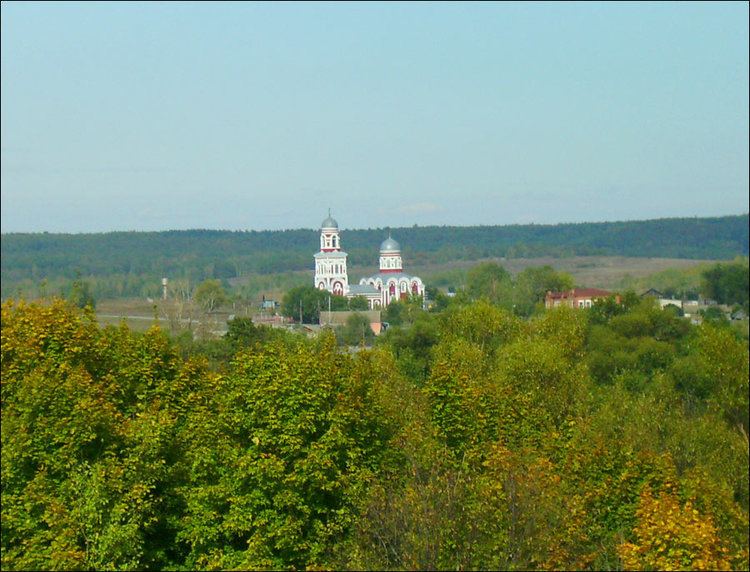Country Russia Area 43,200 km² | Federal district Volga Established February 4, 1939 Area rank 59th | |
 | ||
Destinations Penza, Kuznetsk, Zarechny, Serdobsk, Kamenka Points of interest Tarkhany, Penza Zoo, TsPKiO im VG Belinskogo, Penza State History M, Volga Upland Colleges and Universities Penza State University, Penza State Technolo, Staatliche Pädagogische Universit | ||
Penza Oblast (Russian: Пе́нзенская о́бласть, Penzenskaya oblast) is a federal subject of Russia (an oblast). Its administrative center is the city of Penza. As of the 2010 Census, its population was 1,386,186.
Contents
- Map of Penza Oblast Russia
- Main rivers
- Fauna
- History
- Economy
- Politics
- Demographics
- Religion
- Tourism
- Notable people
- References
Map of Penza Oblast, Russia
Main rivers
Penza Oblast has over 3000 rivers; the overall length is 15,458 km. The biggest rivers are:
Fauna
There are 316 species of vertebrates within the region, including:
Seven existing species of mammals were already acclimatized on land: the American mink, muskrat, raccoon dog, wild boar, Siberian roe deer, red deer and Sika deer. In parallel, work has been carried out to reintroduce the Forest-steppe marmot, the Eurasian beaver and the Russian desman (a species of mole that resembles a muskrat).
In the waters of Penza Oblast, there are about 50 species of fish. The largest body of water - the Sursko reservoir - is home to around 30 species. Commercial species include bream, silver bream, pikeperch, ide, and catfish. In the rivers and smalls pond dwell roach, perch, carp, and pike. The most valuable fish to be found in the natural waters is the sterlet.
History
The regional center of Penza was built in 1663 as a Russian fortress on the border of the Wild Fields, although evidence of the presence of more ancient settlements has been found in the modern city.
Penza Province was established within Kazan Governorate in 1718. It became a separate Penza Governorate on September 15, 1780, which existed until March 5, 1797, when it was dissolved and merged into Saratov Governorate. Penza Governorate was re-established on September 9, 1801 and existed until 1928. Between 1928 and 1937, the territory of the former governorate underwent a number of administrative transformations, ending up as a part of Tambov Oblast in 1937. On February 4, 1939, modern Penza Oblast was established by splitting it out of Tambov Oblast. In March 1939, the Penza Oblast Committee of the CPSU was formed, the first secretary of the committee being Alexander Kabanov.
Economy
Penza Oblast is part of the Volga economic region. The oblast is one of Russia's leading producers of wheat, rye, oats, millet, buckwheat, cereal and forage crops, vegetables, potatoes, mustard, and meat.
Politics
During the Soviet period, the high authority in the oblast was shared among three persons: The first secretary of the Penza CPSU Committee (who in reality had the biggest authority), the chairman of the oblast Soviet (legislative power), and the Chairman of the oblast Executive Committee (executive power). Since 1991, CPSU lost all the power, and the head of the Oblast administration, and eventually the governor was appointed/elected alongside elected regional parliament.
The Charter of Penza Oblast is the fundamental law of the region. The Legislative Assembly of Penza Oblast is the province's standing legislative (representative) body. The Legislative Assembly exercises its authority by passing laws, resolutions, and other legal acts and by supervising the implementation and observance of the laws and other legal acts passed by it. The highest executive body is the Oblast Government, which includes territorial executive bodies such as district administrations, committees, and commissions that facilitate development and run the day to day matters of the province. The Oblast administration supports the activities of the Governor who is the highest official and acts as guarantor of the observance of the oblast Charter in accordance with the Constitution of Russia.
Demographics
Population: 1,386,186 (2010 Census); 1,452,941 (2002 Census); 1,504,309 (1989 Census).
2009 - 1.38 | 2010 - 1.37 | 2011 - 1.36 | 2012 - 1.48 | 2013 - 1.49 | 2014 - 1.53 | 2015 - 1.55 | 2016 - 1.50(e)
Ethnic composition (2010):
Religion
According to a 2012 official survey, 62.9% of the population of Penza Oblast adheres to the Russian Orthodox Church, 2% are unaffiliated generic Christians, 1% are Orthodox Christian believers without belonging to churches or members of non-Russian Orthodox churches, and 7% are Muslims. In addition, 15% of the population declares to be "spiritual but not religious", 9% is atheist, and 3.1% follows other religions or did not give an answer to the question.
